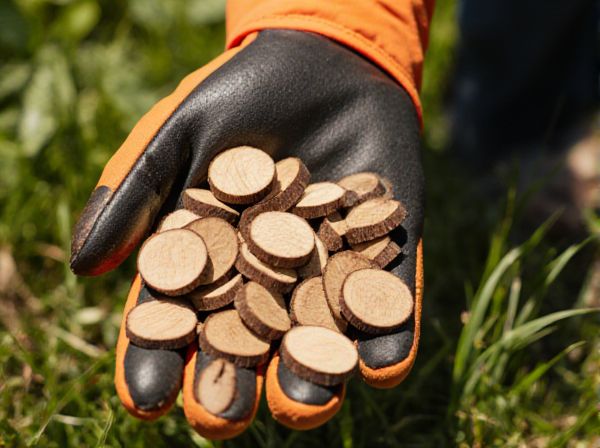
Wood chips vs pine needles Illustration
Wood chips provide excellent moisture retention and gradually enrich the soil with organic matter as they decompose, making them ideal for long-term garden health. Pine needles create a natural, acidic mulch that benefits acid-loving plants like azaleas and blueberries while allowing good air circulation and water drainage. Choosing between wood chips and pine needles depends on the specific plant needs and soil conditions in your garden.
Table of Comparison
| Feature | Wood Chips | Pine Needles |
|---|---|---|
| Source | Chipped hardwood or softwood branches | Fallen pine tree needles |
| Decomposition Rate | Slow - lasts 1-3 years | Faster - lasts 1-2 years |
| pH Effect | Neutral to slightly acidic | Acidic, lowers soil pH |
| Moisture Retention | High - reduces soil evaporation | Moderate - allows soil breathing |
| Weed Control | Effective barrier | Moderately effective |
| Appearance | Coarse, rustic look | Fine, natural forest floor look |
| Best Use | Paths, flower beds, around trees | Acid-loving plants, vegetable gardens |
| Cost | Generally affordable | Often free or low cost in pine areas |
Introduction to Mulch: Wood Chips and Pine Needles
Wood chips and pine needles serve as popular mulch options, each offering unique benefits for soil health and garden aesthetics. Wood chips decompose slowly, improving moisture retention and suppressing weeds effectively, while pine needles acidify the soil, benefiting acid-loving plants like azaleas and blueberries. Selecting the right mulch type depends on plant requirements and soil conditions to optimize garden growth and sustainability.
Composition and Source Comparison
Wood chips mulch consists primarily of shredded tree bark, branches, and wood pieces derived from hardwood or softwood trees, offering a dense, coarse texture that decomposes slowly. Pine needle mulch, sourced from fallen pine needles, is lightweight and acidic, naturally promoting soil acidity beneficial for acid-loving plants. The organic composition of wood chips provides longer-lasting carbon material, while pine needles contribute a more rapid mulch layer but with quicker breakdown due to their fine structure.
Soil Health Benefits: Pine Needles vs Wood Chips
Pine needles create an acidic environment that benefits acid-loving plants and promote slower decomposition, enhancing long-term soil health by improving organic matter content. Wood chips decompose faster, enriching soil with nutrients and increasing microbial activity, which boosts soil fertility and structure. Both mulches improve moisture retention and temperature regulation but have distinct impacts on soil pH and nutrient cycling.
Mulch Impact on Soil pH Levels
Wood chip mulch tends to have a neutral to slightly acidic effect on soil pH, slowly decomposing to enrich soil with organic matter without drastically altering pH levels. Pine needle mulch is more acidic, often lowering soil pH, making it suitable for acid-loving plants like azaleas and blueberries. Choosing between wood chips and pine needles depends on the desired soil pH adjustment and the specific plant requirements in the garden.
Moisture Retention and Drainage Differences
Wood chips provide superior moisture retention by slowly releasing water and preventing rapid evaporation, making them ideal for prolonged soil hydration. Pine needles promote excellent drainage due to their loose, airy structure, reducing waterlogging and improving root aeration. Choosing between wood chips and pine needles depends on whether moisture retention or enhanced drainage is the priority for specific plant needs.
Weed Suppression Effectiveness
Wood chips provide effective weed suppression by creating a thick barrier that blocks sunlight, inhibiting weed seed germination and growth. Pine needles also suppress weeds by acidifying the soil surface, which discourages some weed species from establishing. Wood chips typically offer longer-lasting weed control due to slower decomposition compared to pine needles, which break down more quickly and may require more frequent replenishment.
Application Methods: Best Practices
Wood chips are ideal for pathways and garden beds due to their durability and ability to suppress weeds, best applied in a 2-3 inch layer, avoiding direct contact with plant stems to prevent rot. Pine needles excel as mulch for acidic soil plants like azaleas and blueberries, applied in a thin, even layer to retain moisture and improve soil acidity while allowing proper airflow. Both materials benefit from periodic replenishing and should be spread evenly to maximize water retention and soil health.
Longevity and Maintenance Requirements
Wood chip mulch typically lasts longer than pine needles, often maintaining effectiveness for up to two years, whereas pine needles generally decompose within one year. Wood chips require less frequent replenishing and are better at suppressing weeds over time, reducing overall maintenance efforts. Pine needles, while lighter and easier to spread, demand more regular replenishment to maintain soil coverage and moisture retention.
Pros and Cons: Wood Chips vs Pine Needles
Wood chips provide excellent moisture retention and nutrient release as they decompose, but they can attract pests and take longer to break down compared to pine needles. Pine needles offer superior acidity suitable for acid-loving plants and allow better air circulation, though they may require more frequent replenishing due to faster decomposition and can create a mat that hinders water penetration. Choosing between wood chips and pine needles depends on soil pH needs, plant types, and desired maintenance frequency.
Choosing the Right Mulch for Your Garden
Wood chips provide excellent moisture retention and weed suppression, making them ideal for vegetable beds and pathways, while pine needles offer superior acidity and light coverage, benefiting acid-loving plants like azaleas and blueberries. Wood chips decompose slowly, enriching soil structure over time, whereas pine needles break down faster, requiring more frequent replenishment. Selecting mulch depends on your garden's soil pH needs, plant types, and maintenance frequency.
Wood chips vs pine needles Infographic

 gardendif.com
gardendif.com